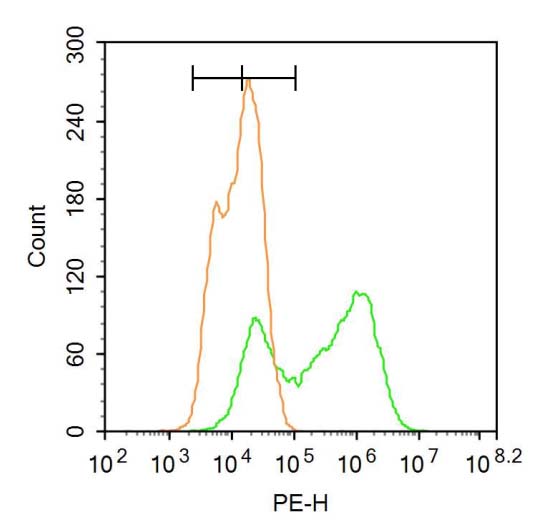
Rabbit Anti-Sumo2+3 antibody
Sumo 2 + Sumo 3; Sumo2/3; HSMT3; MGC117191; OTTHUMP00000115275; OTTHUMP00000115276; OTTHUMP00000115277; Sentrin 2; Small ubiquitin like modifier 2; Small ubiquitin like modifier protein 3; Small ubiquitin related modifier 2; Small ubiquitin related modifi
View History [Clear]
Details
Product Name Sumo2+3 Chinese Name Ubiquitin样蛋白Sumo2/3抗体 Alias Sumo 2 + Sumo 3; Sumo2/3; HSMT3; MGC117191; OTTHUMP00000115275; OTTHUMP00000115276; OTTHUMP00000115277; Sentrin 2; Small ubiquitin like modifier 2; Small ubiquitin like modifier protein 3; Small ubiquitin related modifier 2; Small ubiquitin related modifier 3; SMT3 A; SMT3 B; SMT3 H1; SMT3 H2; SMT3 homolog 1; SMT3 homolog 2; SMT3 homolog; SMT3 suppressor of mif two 3 homolog 1; SMT3 suppressor of mif two 3 homolog 2 (S. cerevisiae); SMT3 suppressor of mif two 3 homolog 2; SMT3 suppressor of mif two 3 homolog 3 (S. cerevisiae); SMT3 suppressor of mif two 3 homolog 3; SMT3A; SMT3B; SMT3H1; SMT3H2; Sumo 2; Sumo 3; Sumo2; Sumo3; Suppressor of mif two 3 homolog 2; Suppressor of mif two 3 homolog 3; Ubiquitin like protein SMT3A; Ubiquitin like protein SMT3B; SUMO2_HUMAN; SUMO3_HUMAN. Research Area Cell biology Neurobiology Cyclin Ubiquitin Immunogen Species Rabbit Clonality Polyclonal React Species Human, (predicted: Mouse, Rat, Chicken, Cow, Horse, Rabbit, Zebrafish, ) Applications WB=1:500-2000 ELISA=1:5000-10000 IHC-P=1:100-500 IHC-F=1:100-500 Flow-Cyt=3ug/test ICC=1:100-500 IF=1:100-500 (Paraffin sections need antigen repair)
not yet tested in other applications.
optimal dilutions/concentrations should be determined by the end user.Theoretical molecular weight 10.9+10.5kDa Cellular localization The nucleus Form Liquid Concentration 1mg/ml immunogen KLH conjugated synthetic peptide derived from human Sumo2+Sumo3: 21-95/95 Lsotype IgG Purification affinity purified by Protein A Buffer Solution 0.01M TBS(pH7.4) with 1% BSA, 0.03% Proclin300 and 50% Glycerol. Storage Shipped at 4℃. Store at -20 °C for one year. Avoid repeated freeze/thaw cycles. Attention This product as supplied is intended for research use only, not for use in human, therapeutic or diagnostic applications. PubMed PubMed Product Detail The small ubiquitin-related modifier (SUMO) proteins, which include SUMO-1, SUMO-2 and SUMO-3, belong to the ubiquitin-like protein family. Like ubiquitin, the SUMO proteins are synthesized as precursor proteins that undergo processing before conjugation to target proteins. Also, both utilize the E1, E2, and E3 cascade enzymes for conjugation. However, SUMO and ubiquitin differ with respect to targeting. Ubiquitination predominantly targets proteins for degradation, whereas sumoylation targets proteins to a variety of cellular processing, including nuclear transport, transcriptional regulation, apoptosis and protein stability. The unconjugated SUMO-1, SUMO-2 and SUMO-3 proteins localize to the nuclear membrane, nuclear bodies and cytoplasm, respectively. SUMO-1 utilizes Ubc9 for conjugation to several target proteins, which include IkBa, MDM2, p53, PML and Ran GAP1. SUMO-2 and SUMO-3 contribute to a greater percentage of protein modification than does SUMO-1, and unlike SUMO-1, they can form polymeric chains. In addition, SUMO-3 regulates b-Amyloid generation and may be critical in the onset or progression of Alzheimer’s disease.
Function:
SUMO proteins, such as Sumo 2 and Sumo 3, post-translationally modify numerous cellular proteins and affect their metabolism and function. However, unlike ubiquitination, which targets proteins for degradation, sumoylation participates in a number of cellular processes, such as nuclear transport, transcriptional regulation, apoptosis, and protein stability. Sumo 2 and Sumo 3 are highly homologous, hence it is very difficult to produce antibodies which distinguish them.
Subunit:
Homotrimer (Potential). Crystal packing analysis suggests a possible trimeric assembly, of which the biological significance remains to be determined. Interacts with SAE2 and UBE2I. Covalently attached to a number of proteins. Interacts with PELP1. Interacts with USP25; the interaction sumoylates USP25. Interacts with SIMC1, CASP8AP2, RNF111 AND SOBP (via SIM domains).
Subcellular Location:
Cytoplasmic (SUMO3) and Nuclear (SUMO2)
Tissue Specificity:
Broadly expressed.
Post-translational modifications:
Polymeric chains can be formed through Lys-11 cross-linking. Polymeric SUMO2 chains undergo 'Lys-6'-, 'Lys-11'-, 'Lys-48'- and 'Lys-63'-linked polyubiquitination by RNF4.
Cleavage of precursor form by SENP1 or SENP2 is necessary for function.
Similarity:
Belongs to the ubiquitin family. SUMO subfamily.
Contains 1 ubiquitin-like domain.
SWISS:
P61956
Gene ID:
6613
Database links:Entrez Gene: 6612 Human
Entrez Gene: 6613 Human
Entrez Gene: 170930 Mouse
Entrez Gene: 20610 Mouse
Omim: 602231 Human
Omim: 603042 Human
SwissProt: P55854 Human
SwissProt: P61956 Human
SwissProt: P61957 Mouse
SwissProt: Q9Z172 Mouse
Product Picture
Primary Antibody (green line): Rabbit Anti-SUMO3 antibody (SL7338R)
Dilution: 1μg /10^6 cells;
Isotype Control Antibody (orange line): Rabbit IgG .
Secondary Antibody : Goat anti-rabbit IgG-PE
Dilution: 3μg /test.
Protocol
The cells were fixed with 4% PFA (10min at room temperature)and then permeabilized with 90% ice-cold methanol for 20 min at-20℃. The cells were then incubated in 5% BSA to block non-specific protein-protein interactions for 30 min at at room temperature .Cells stained with Primary Antibody for 30 min at room temperature. The secondary antibody used for 40 min at room temperature. Acquisition of 20,000 events was performed.
References (0)
No References
Bought notes(bought amounts latest0)
No one bought this product
User Comment(Total0User Comment Num)
- No comment



 +86 571 56623320
+86 571 56623320
 +86 18668110335
+86 18668110335

